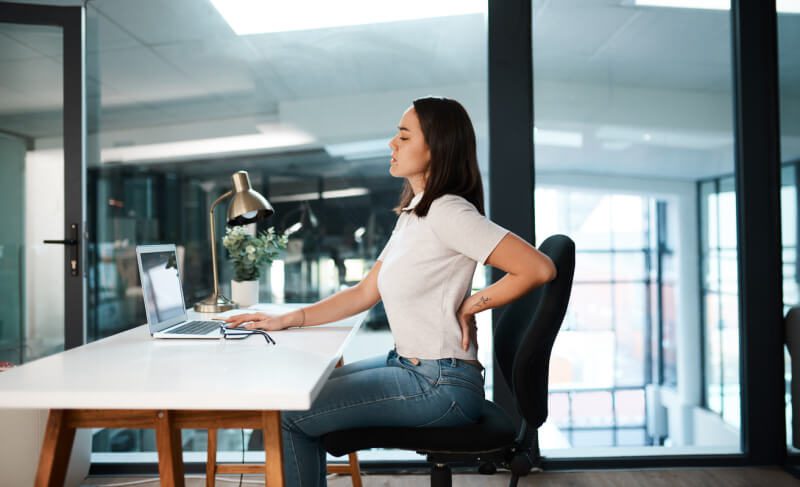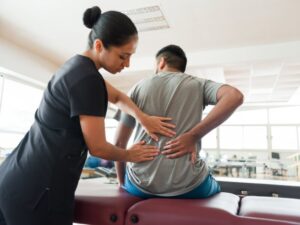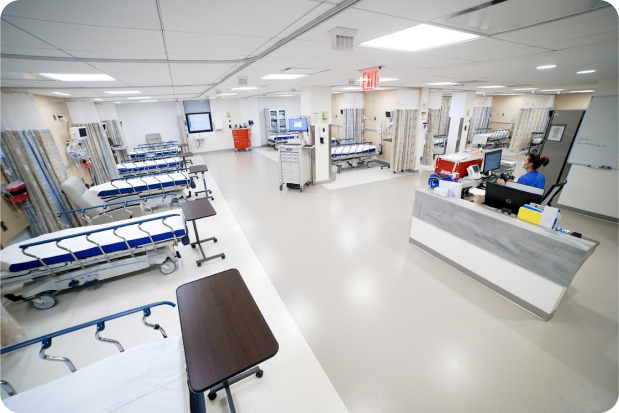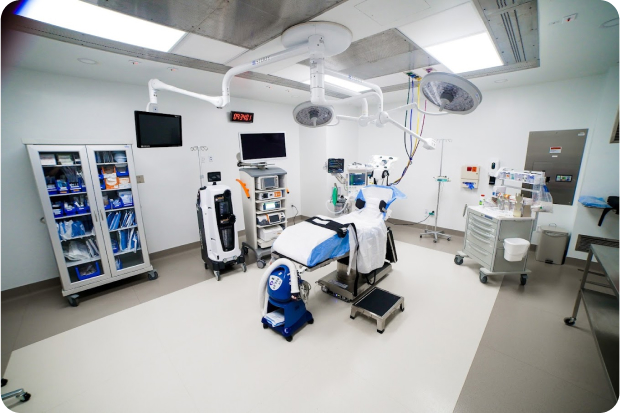 OUR LOCATIONSCall to book (212) 604-1300
OUR LOCATIONSCall to book (212) 604-1300
 OUR LOCATIONSCall to book (212) 604-1300
OUR LOCATIONSCall to book (212) 604-1300

Every year, millions of Americans miss work days because of lower back pain. It’s a common condition caused by several factors, ranging from something as simple as poor posture and strained muscles to a more serious condition like spinal stenosis. Back pain is also aggravated even by normal movements like walking or sitting.
So what are the possible causes of lower back pain that gets worse when sitting? Lower back pain when sitting might be a result of poor posture, strained muscles, trauma, or injury. However, it might also be a symptom of a more serious health condition like sciatica, herniated disk, spinal stenosis, sacroiliac joint dysfunction, degenerative disc disease, spondylolisthesis, and cauda equina syndrome.
According to the American Chiropractic Association, around 31 million Americans experience common low back pain at some point in their lives. It’s a pervasive condition that affects a person’s mobility and quality of life. Both acute and chronic pain in the lower back are symptoms of different musculoskeletal problems that worsen without the right treatment.
But before finding the best treatment for lower back pain, it’s important to identify the problem first. Here are ten possible reasons why you’re experiencing severe lower back and hip pain when sitting:
Prolonged sitting and leaning in front of a computer screen often results in poor posture. Hunching puts strain on the ligaments, bones, and muscles that support the whole body. This leads to pain, weakness, and stiffness in the lower back. Even if the back pain isn’t a result of poor posture, slouching makes the condition worse so it’s important to always keep the posture in check when sitting or standing.
A strained muscle in the lower back region is also called “lumbar strain”. It occurs when the back muscles are overstretched or twisted due to sudden or repetitive movements. Aside from the lower back, the pain or stiffness might also extend down to the buttocks. This might be mistaken for sciatica, but the important difference is that the pain caused by strained muscles isn’t caused by a pinched sciatic nerve.
Muscle strain usually goes away after a few weeks of medication or physical therapy, but it might develop into chronic lower back pain (“chronic LBP”) if left untreated. Poor sitting posture might also contribute to muscle strain.
Lower back pain might also be triggered when seated if a person has been through an accident or experienced an injury. Trauma or injury might be sustained because of a sports or car accident. People with jobs that involve lifting heavy objects are also prone to suffering from injury or trauma if they lift something incorrectly.
Sciatica or radiculopathy refers to the chronic or acute pain in the lumbar spine that extends to one side of the buttocks, down to the thigh, leg, knee, and even the foot. This happens when the sciatic nerve that extends from the spine to the back of the legs is pinched.
Most patients feel sciatic nerve pain as a dull ache, but it might feel like an electric shock. It might also come as numbness or a tingling sensation in the lower half of the body. Sciatica is also a symptom of a more serious condition like pelvic injury or a spine problem like herniated disc and spinal stenosis.
Spinal discs are the rubbery pads found between each vertebra along the spine. These discs serve as shock absorbers and cushions for the spine. Each spinal disc has a thick outer layer (annulus fibrosus) that protects the soft gelatinous core (nucleus pulposus). Herniated disc (also called a ruptured or slipped disk) is a spine condition in which the soft inner layer leaks through the damage in the tough outer layer and presses on a nearby nerve.
Herniated discs might develop because of aging, but they might also be a result of repetitive motion injury or lifting a heavy object incorrectly. Disc herniation might develop in both the upper and lower part of the spine. A cervical herniated disc is found in the upper part of the spine, while lumbar herniated disc refers to the slipped discs in the lower half the spinal column.
Disc herniation in the cervical part of the spine typically leads to neck pain that’s aggravated during bed rest. On the other hand, a slipped intervertebral disc in the lumbar vertebra causes back and leg pain, tingling, or numbness. However, there are also some patients who don’t experience symptoms at all.
Lumbar spinal stenosis is a condition in which the spinal canal in the lower part of the back narrows. This causes strain and pressure on the spinal cord and the nerve root that extend from the spine to the muscles. Spinal stenosis might occur in different parts of the spine, but it’s more common in the five lumbar vertebrae that connect the upper spine and the pelvis.
The most common cause of spinal stenosis is gradual wear and tear, which is why older people are more vulnerable to developing this condition than other age groups. Other possible causes of spinal stenosis include spinal tumors, bone diseases, history of spine surgery, and rheumatoid arthritis.
The sacroiliac joint is located in the lower region of the spine and is responsible for absorbing the shock between the pelvis and the upper body. This joint is helpful bending forward or backward, which is why patients with sacroiliac joint dysfunction often experience pain when transitioning from a standing to a sitting position. It’s further aggravated when more weight is placed on one side of the body when sitting.
Patients with sacroiliac pain dysfunction also experience instability, sciatic-like pain, and stiffness. Almost anyone may develop sacroiliac joint dysfunction, but people with gait issues, a history of lower back surgery, jobs that require repetitive motion, and recent childbirth are more vulnerable than others.
This condition refers to the damaged discs in the lumbar spine bones. Disc degeneration is normal for older people, but it might also be due to injuries or trauma sustained from an accident. Degenerative disc disease is often confused with a herniated disc, but the main difference between the two is that the former involves the loss of water and gelatinous components over time while the latter is just the discs bulging out for different reasons.
But like slipped discs, degenerative disc disease also causes sciatica in a patient once the disc presses against the sciatic nerve. This shoots a sharp pain in one side of the body’s lower half.
This condition occurs when one of the vertebrae slides over the other one below it. It develops in the lumbar spine of adolescents and adults. Some people may also have spondylolisthesis since birth, but others may also develop it as they age.
Aside from lower back pain, patients with spondylolisthesis might also experience tight hamstrings, increased inward curve of the spine (lumbar lordosis), numbness on one or both legs, and urinary incontinence.
Cauda equina syndrome is a condition that affects the bundle of nerve roots found at the lower end of the spine. These nerves are responsible for sending and receiving messages from the feet, legs, and pelvic organs. CES is more prevalent in adults, but it might also occur in children with spinal birth defects.
This rare condition is typically considered a surgical emergency because it might lead to incontinence and leg paralysis. Most patients with cauda equina syndrome experience severe pain, numbness, altered sensations in the lower half of the body, problems with bowel or bladder functions, and sexual dysfunction.

Since lower back pain is a common complaint among people of all ages, most of them brush the discomfort off at first before consulting a physician. But if the pain is persistent for a few weeks with no signs of improvement, it’s better to get an accurate diagnosis and treatment. Make sure to visit a doctor if the lower back pain is accompanied by:
Persistent lower back pain affects daily activities and quality of life, which is why it’s important to seek pain relief treatments that directly target the main cause of the back pain. Leaving it untreated might lead to worse complications that require surgery. Here are some of the most common treatments for lower back pain when sitting:
Most cases of lower back pain are treated with simple home remedies, such as:
Learn more: 9 Simple Stretches for Lower Back Pain Relief
Physical therapy is another effective method to relieve back pain without going through surgery. Depending on the patient’s exact condition, the doctor might recommend passive, active, or a combination of both types of physical therapy for maximum relief.
Chiropractic care and acupuncture are two of the most popular kinds of alternative medicine that help patients get rid of lower back pain effectively. Chiropractic medicine involves manually adjusting the misalignments along the spine while acupuncture uses thin needles that are poked to the pressure points of the body to relieve muscle tension.
A surgical procedure is only considered as the last resort if the medications, physical therapy, and other conservative treatments don’t work. However, certain spine conditions like cauda equina syndrome require surgery as the only viable procedure. Find out if you’re a candidate for spine surgery by consulting with a licensed spine specialist.
Learn more: A Guide to Lower Back Pain Relief
In our NYC sports injury clinic, we want our patients to return to their pain-free lives as soon as possible. Our highly trained staff specializes in non-surgical treatments to alleviate back pain and strengthen the spine muscles.
Consult with our experts today to get an accurate diagnosis of your condition. We also prioritize patient comfort and safety with each treatment performed inside our state-of-the-art facilities. Visit our website now to learn more about our services or book an appointment with one of the country’s top spine doctors.






